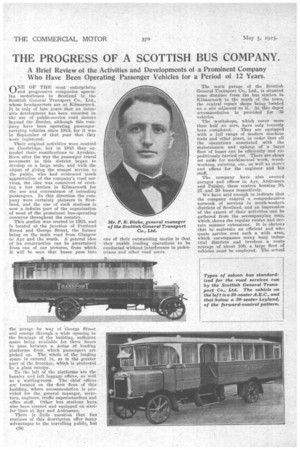THE PROGRESS OF A SCOTTISH BUS COMPANY.
Page 14

Page 15

If you've noticed an error in this article please click here to report it so we can fix it.
A Brief Review of the Activities and Developments of a Prominent Company Who Have Been Operating Passenger Vehicles for a Period of 12 Years.
O(1 NE OF THE most enterprising and progressive companies operating motorbuses in Scotland is the Scottish General Transport Co., Ltd., whose headquarters are at Kilmarnock. It is only of late years that an intensive development has been recorded in the use of public-service road motors beyond the Border, although this company have been operating passengercarrying vehicles since 1913, for it was in September of that year that they were registered.
Their original activities were centred on Coathridge, but in 1915 they extended their, ramifications to Ayrshire. Soon after the war the passenger travel movement in this district began to develop on a large scale, and with the object of giving the utmost service to the public, who had evidenced much appreciation of the company's road services, the idea was conceived of erecting a bus station in Kilmarnock for the use and convenience of intending passengers. In this direction the company were certainly pioneers in Scotland, and the use of such stations is now a definite part of the organization of most of the prominent bus-operating concerns throughout the country.
This station was erected in 1923, and is located at. the junction of Portland Street and George Street, the former being on the main road from Glasgow to Ayr and the south. A general idea of its construction can be ascertained from one of our pictures, from which it will be seen that buses pass into the garage by way of George Street and emerge through a wide opening in the frontage of the building, sufficient space being availablefor three buses to pass between a series of loading platforms from .which passengers are picked up. The whole of the loacling space is covered in, as is the greater part of the frontage, which is protected
by a glass canopy. .
To .the left of the platforms are the inquiry and left luggage offices, as well as a waiting-roorn. The chief offiCes are located on the first floor of this building, where accommodation is provided for the, general manager, secretary, engineer, traffic superintendent and office staff. Other bus stations have also been erected and equipped on similar lines at Ayr and Ardrossan.
There is little question that bus stations of this description offer Many advantages to the travelling public, but C30 one of their outstanding merits is that they enable loading operations to be conducted without interference to pedestrians and other road users. The main garage of the Seottish General Transport Co., Ltd., is situated some distance from the bus station in Kilmarnock to the south of the town, the central repair shops being located on a site adjacent to it. At this depot accommodation is provided for 35 vehicles.
The workshops, which cover -more than half an acre, have only -recently been completed. They are equipped with a full range of modern machine tools and other plant, in order that all the operations associated with the maintenance and upkeep of a largo fleet of buses can be efficiently and expeditiously derided out. There are shops set aside for machine-tool work, wood, working, painting, etc., as well as store.: and offices for the engineer and his staff.
The company have also erected garages and offices in Ayr, Ardrossait and Paisley, these centres housing 30, 27 and 20 buses respectively.
We have said enough to indicate that the company control a comprehensive. network of services in south-western districts of Scotland, and an impression of the extent of their activities can be gathered from the accompanying map, which shows the regular routes and certain summer extensions. It is obvious that to maintain an efficient and adequate service over such a wide area, which encompasses many busy industrial districts and involves a route mileage of about 100, a large fleet of vehicles must he employed. The actual lumber of vehicles in service and building is 84, made up of 76 single-decker saloon motorbuses and eight motor coaches.
In the selection of vehicles for public service, the company have standardized certain makes of chassis for specific needs, with the result that the fleet is composed of two types only. For carrying 30-seater bus bodies and 28-82seater coach bodies, A.E.C. chassis are exclusively used, whilst the basis of the larger buses, of which 54, each seating 39 passengers, are in use, is the Leyland chassis. The general construction of each type of bus can be seen from certain of the pictures which we publish, and, in the case of the Leyland, it will be noted that forward .control is provided, the driver being enclosed in a half-width cab situated alongside the engine.
The general efficiency of the company's services and the consistent run ling of the vehicles are undoubtedly .argely due to this strict and wise adherence to a policy of .sttindardizaion. Apart from ensuring good service to the public, it results in a simplifieadon of maintenance work and stores organization.
Some indication of the importance of the Scottish General Transport Co.'s services to the inhabitants of the districts which they serve is to be found in the number a bus-miles Operated and the number of passengers carried during last year, the i?espeetive totals being 1,537,736 and 7,129,568. These figures also afford evidence of the increasing popularity of the services, especially' when compared with corresponding aggregates for previous years.
The general manager of the Scottish General Transport Co., Ltd., is Mr. P. It Blake, A.M.I.E.E., whose portrait is reproduced on the previous page. •
































